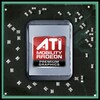ATI Mobility Radeon HD 5870 Crossfire vs ATI Mobility Radeon HD 5830 vs ATI Mobility Radeon HD 5850
ATI Mobility Radeon HD 5870 Crossfire
► remove from comparison
The ATI Mobility Radeon HD 5870 Crossfire (CF) (or ATI Mobility Radeon HD5870 X2) is a high-end DirectX 11 capable graphics solution for notebooks by AMD. It consists of two single Mobility HD5870 cards bound together using Crossfire (similar to Nvidia's SLI). In this setup, alternate frame rendering (AFR) is the most common rendering technique. At the time of announcement (Jan 2010), the 5870 CF paired with GDDR5 memory was the fastest laptop graphics solution available. Technically, the chip is based on the desktop Radeon HD 5770 (RV840), but with a slower clock rate.
Because each card renders a different frame, the Crossfire solution may suffer from micro stuttering at the 20-30 FPS range as there are irregular delays between sequential frames. Therefore, the Crossfire HD 5870 may need higher framerates for fluent gameplay.
The memory interface of the Mobility 5870 is composed of two 64 bit wide controllers leading to a 128 bit memory bus that can access up to 1024 MB of DDR3 or GDDR5 memory. If DDR3 is used by the laptop vendor, then the graphics performance will suffer noticeably.
The HD5870 CF offers 2x800 MADD cores (called Stream Processors) which are grouped in 2x160 5-dimensional groups. The cores support DirectX 11 functions in hardware (Tessellation, OIT, Post-Processing, Shadows, HDR Texture Compression). Furthermore, 16 ROPs, 40 TMUs, and 40 TAUs can be found on each chip. All in all, 2x1040 Million transistors offer a theoretic computation power of up to 2x1.12 TFLOPS.
According to AMD, the HD 5000 series was also improved with regards to general computing. For comparison, the HD 4000 series received no such optimizations. Therefore, the performance of ATI stream, OpenCL, and DirectCompute 11 applications should be noticably better with the Mobility 5870 Crossfire.
Compared to the previous generation (in this case the Mobility Radeon HD 4870 X2), the HD5870 X2 should be about 20% faster according to AMD. This is only valid for a GDDR5 version of the HD5870 (otherwise the memory bus would be the bottle neck). The gaming performance of the CF solution should be sufficient for all current games (2009-2010) in high resolution and high detail settings with some AA enabled. Compared to a GeForce GTX 285M SLI, the 5870 CF should be faster (altough the SLI driver support by Nvidia has been known to be a bit more superior).
The Mobility Radeon HD 5000 series includes an improved video processor (UVD2) to decode HD videos with the graphics card. The new version is able to decode two HD streams simultaneously (e.g., for Blu-Ray picture in picture) if the graphics card offers enough memory bandwidth (possibly only versions with GDDR5). Since Flash 10.1 Beta, the 5000 series has also been able to help accelerate Flash HD videos (like YouTube).
A special feature of the HD 5000 series is its ability to transmit HD audio formats (like Dolby True HD or DTS HD Master Audio) with up to 8 channels and 192 kHz / 24 Bit over HDMI 1.3a.
As the desktop HD 5000 series, the Mobility HD 5870 also supports Eyefinity to connect up to 6 monitors to the graphics chip. Of course, this depends on how many monitor outputs the laptop vendor adds to the notebook and how they are wired. Most laptops will support up to three screens simultaneously (one internal and two external).
Due to the high power consumption of the Mobility Radeon HD 5870 CF, it is only suited for large laptops with good (and possibly loud) cooling solutions. According to AMD, the performance per watt ratio (same power consumption, better performance) and the idle power consumption have been improved (thanks to Memory Clock Scaling and Clock Gating). Furthermore, the chip does support PowerXpress (with an AMD chipset) and Switchable Graphics (Intel) to switch between the dedicated and chipset / integrated graphics card.
Compared to desktop graphics cards, the Mobility Radeon HD 5870 CF should perform somewhere between a Radeon HD 5750 and 5770 in Crossfire mode based on the shader count of the 5770 and the clock rate of 5750.
ATI Mobility Radeon HD 5830
► remove from comparison
The ATI Mobility Radeon HD 5830 is a performance class DirectX 11 capable graphics card for laptops / notebooks by AMD. Technically the HD5830 is a slower clocked HD 5850 without the support for fast GDDR5 graphics memory. Therefore, the 128 bit memory bus in conjunction with DDR3 memory may be a performance bottleneck. As all cards of the Mobility HD 5800 series, the HD 5830 is based on the desktop HD 5770 (RV840) chip.
The memory interface of the Mobility 5830 is composed out of two 64 bit wide controllers leading to a 128 bit memory bus that can access up to 1024 MB of DDR3. Because of the small bus width and the lack of GDDR5 memory, the memory performance should be the bottleneck of this card.
The 5830 offers 800 MADD cores (called Stream Processors) which are grouped in 160 5-dimensional groups. The cores support DirectX 11 functions in hardware (Tessellation, OIT, Post-Processing, Shadows, HDR Texture Compression). Furthermore, 16 ROPs, 40TMUs, and 40 TAUs can be found on the chip. All in all the chip can deliver up to 0.8 TFLOPs.
According to AMD, the HD 5000 series was also improved regarding general computing (as the HD4000 series was not optimized for this). Therefore, the performance of ATI stream, OpenCL, and DirectCompute 11 applications should be noticable better.
The 3D performance of the Mobility HD 5830 should be in the performance class of the GTS 250M - GTX 260M and therefore capable of generating fluent framerates in all current games (2009). High end games like Crysis wont run in very high details, but most games should run with playable framerates.
The Mobility Radeon HD 5000 series includes an improved video processor (UVD2) to decode HD videos with the graphic card. The new version is able to decode two HD streams simultaneously (e.g., for Blu-Ray picture in picture) if the graphic card offers enough memory bandwidth (only GDDR5 versions - and therefore perhaps not in the HD5830?). Since the Flash 10.1 Beta, the 5000 series is also able to help accelerate Flash HD videos (like YouTube).
A special feature of the HD 5000 series is its ability to transmit HD audio formats (like Dolby True HD or DTS HD Master Audio) with up to 8 channels and 192 KHz / 24 Bit over HDMI 1.3a.
As the desktop HD 5000 series, the Mobility HD 5830 also supports Eyefinity to connect up to 6 monitors to the graphics chip. Of course, this depends on how many and what kind of monitor outputs the laptop vendor adds to the laptop (and how they are wired). It seems like only DisplayPort outputs support Eyefinity and therefore up to now only one laptop supports more than 2 displays (Envy 17).
The power consumption of 24 Watt (according to AMD) is not that high. Therefore, this GPU could also be used in 15-16" laptops.
ATI Mobility Radeon HD 5850
► remove from comparison
The ATI Mobility Radeon HD 5850 is a high-end DirectX 11-capable graphics card for notebooks by AMD based on the desktop HD 5770 (RV840) chipset. Essentially, the HD5850 is a Mobility Radeon HD 5870 that has been underclocked by about 11 percent. In contrast to the HD 5870, the 5850 is sometimes equipped with slow DDR3 graphics memory.
The memory interface of the Mobility 5850 is composed of two 64 bit wide controllers leading to a 128 bit memory bus that can access up to 1024 MB of either DDR3 or GDDR5 memory (or even up to just 512 MB of G=DDR3 in lower-end models). If (G)DDR3 is used by the laptop vendor, then the performance of the 5850 will suffer by a noticeable margin.
The 5850 offers 800 MADD cores (called Stream Processors) that are grouped in 160 5-dimensional groups. The cores support DirectX 11 functions in hardware (e.g., Tessellation, OIT, Post-Processing, Shadows, HDR Texture Compression). Furthermore, 16 ROPs, 40TMUs, and 40 TAUs can be found on the chip. All in all, the 1040 Million transistors offer a theoretical computation power of up to 1.12 TFLOPS.
According to AMD, the HD 5000 series has improved general computing algorithms that the HD 4000 series lacks. Therefore, the performance of applications such as ATI stream, OpenCL, and DirectCompute 11 should be significantly better.
The 3D performance of the Mobility HD 5850 depends heavily on the used graphics RAM, or VRAM. As long as fast GDDR5 is used, the performance should be between a GeForce GTX 260M - 280M in the high end segment. Therefore, all current games as of 2009 should be playable in high details with high resolutions. With DDR3 memory, however, the performance should drop noticeably because of the relatively narrow 128 Bit memory bus. In fact, the GDDR5 version (on par with a GTX 285M) is about 40% faster in the 3DMark Vantage benchmark than the DDR3 equipped version (on par with a GTX 260M).
Exactly which games can or cannot run fluently on the 5850 can be found on the lower section of this page.
The Mobility Radeon HD 5000 series includes an improved video processor (UVD2) to decode HD videos with the graphics card. The new version is able to decode two HD streams simultaneously (e.g., for Blu-Ray picture in picture), given that the graphics card offers enough memory bandwidth. As a result, it is entirely possible that only AMD GPUs paired with GDDR5 VRAM can decode multiple HD streams in parallel. Beginning with Flash 10.1 Beta, the 5000 series has also been able accelerate Flash HD videos such as on YouTube.
A special feature of the HD 5000 series is its ability to transmit HD audio formats (like Dolby True HD or DTS HD Master Audio) with up to 8 channels and 192 KHz / 24 Bit over HDMI 1.3a.
As with the desktop HD 5000 series, the Mobility HD 5850 also supports Eyefinity to connect up to 6 monitors to the graphics chip. Of course, this depends on how many native monitor outputs the laptop vendor adds to the laptop (and how they are wired). Still, according to our sources, the laptop would specifically need DisplayPort outputs for Eyefinity to work, which, as of this writing, is only available on the HP Envy 17.
Furthermore, the 5850 chip should support PowerXpress (with AMD chipset) and Switchable Graphics (Intel) to switch between the dedicated and chipset / CPU graphics card.
Due to the high power consumption of the Mobility Radeon HD 5850 (40-60 Watt of the 5800 series), the GPU is only suited for large laptops with high-performance (and possibly loud) cooling solutions. According to AMD, the performance-per-watt ratio and the idle power consumption have both been improved thanks to Memory Clock Scaling and Clock Gating.
Compared to desktop graphics cards, the Mobility Radeon HD 5850 should perform slightly slower than a Radeon HD 5750 due to the slower clock rate found on the mobile AMD GPU.
| ATI Mobility Radeon HD 5870 Crossfire | ATI Mobility Radeon HD 5830 | ATI Mobility Radeon HD 5850 | |||||||||||||||||||||||||||||||||||||
| Mobility Radeon HD 5800 Series |
|
|
| ||||||||||||||||||||||||||||||||||||
| Codename | Broadway-XT | Broadway | Broadway-PRO | ||||||||||||||||||||||||||||||||||||
| Architecture | Terascale 2 | Terascale 2 | Terascale 2 | ||||||||||||||||||||||||||||||||||||
| Pipelines | 1600 - unified | 800 - unified | 800 - unified | ||||||||||||||||||||||||||||||||||||
| Core Speed | 700 MHz | 500 MHz | 625 MHz | ||||||||||||||||||||||||||||||||||||
| Memory Speed | 1000 MHz | 800 MHz | 2000 MHz | ||||||||||||||||||||||||||||||||||||
| Memory Bus Width | 128 Bit | 128 Bit | 128 Bit | ||||||||||||||||||||||||||||||||||||
| Memory Type | DDR3, GDDR3, GDDR5 | DDR3, GDDR3 | DDR3, GDDR3, GDDR5 | ||||||||||||||||||||||||||||||||||||
| Max. Amount of Memory | 2x1024 MB | 1024 MB | 1024 MB | ||||||||||||||||||||||||||||||||||||
| Shared Memory | no | no | no | ||||||||||||||||||||||||||||||||||||
| API | DirectX 11, Shader 5.0 | DirectX 11, Shader 5.0 | DirectX 11, Shader 5.0 | ||||||||||||||||||||||||||||||||||||
| Power Consumption | 120 Watt | 24 Watt | 39 Watt | ||||||||||||||||||||||||||||||||||||
| technology | 40 nm | 40 nm | 40 nm | ||||||||||||||||||||||||||||||||||||
| Features | Eyefinity (up to 6 displays), HD Audio (Dolby True HD, DTS HD), HDMI 1.3a, Avivo HD (UVD2.2) | Eyefinity (up to 6 displays), HD Audio (Dolby True HD, DTS HD), HDMI 1.3a, Avivo HD (UVD2.2) | Eyefinity (up to 6 displays), HD Audio (Dolby True HD, DTS HD), HDMI 1.3a, Avivo HD (UVD2.2) | ||||||||||||||||||||||||||||||||||||
| Notebook Size | large | large | large | ||||||||||||||||||||||||||||||||||||
| Date of Announcement | 07.01.2010 | 07.01.2010 | 07.01.2010 | ||||||||||||||||||||||||||||||||||||
| Information | 2x1.12 TFLOPS | 1.0 TFLOPS | 1.0 TFLOPS | ||||||||||||||||||||||||||||||||||||
| Link to Manufacturer Page | www.amd.com | www.amd.com | |||||||||||||||||||||||||||||||||||||
| Transistors | 1 Billion |
Benchmarks
3DM Vant. Perf. total + ATI Mobility Radeon HD 5870 Crossfire
specvp11 snx-01 + ATI Mobility Radeon HD 5870 Crossfire
Average Benchmarks ATI Mobility Radeon HD 5870 Crossfire → 100% n=3
Average Benchmarks ATI Mobility Radeon HD 5830 → 39% n=3
Average Benchmarks ATI Mobility Radeon HD 5850 → 46% n=3
* Smaller numbers mean a higher performance
1 This benchmark is not used for the average calculation
Game Benchmarks
The following benchmarks stem from our benchmarks of review laptops. The performance depends on the used graphics memory, clock rate, processor, system settings, drivers, and operating systems. So the results don't have to be representative for all laptops with this GPU. For detailed information on the benchmark results, click on the fps number.

Fifa 11
2010
Mafia 2
2010
StarCraft 2
2010
Metro 2033
2010
CoD Modern Warfare 2
2009Average Gaming ATI Mobility Radeon HD 5870 Crossfire → 100%
Average Gaming 30-70 fps → 100%
Average Gaming ATI Mobility Radeon HD 5850 → 69%
Average Gaming 30-70 fps → 71%
| ATI Mobility Radeon HD 5870 Crossfire | ATI Mobility Radeon HD 5830 | ATI Mobility Radeon HD 5850 | |||||||||||||||||||
|---|---|---|---|---|---|---|---|---|---|---|---|---|---|---|---|---|---|---|---|---|---|
| low | med. | high | ultra | QHD | 4K | low | med. | high | ultra | QHD | 4K | low | med. | high | ultra | QHD | 4K | ||||
| Call of Duty: Black Ops | 57 | 52 | 49 | 37 | |||||||||||||||||
| Fifa 11 | 250.4 | 167.3 | 83.9 | 58.7 | 150.8 | 90.8 | 54.9 | ||||||||||||||
| Mafia 2 | 56.7 | 56.6 | 56.9 | 56.8 | 55 | 48 | 30 | ||||||||||||||
| StarCraft 2 | 158.8 | 57.9 | 57.9 | 51.2 | 160 | 52 | 39 | 23 | |||||||||||||
| Metro 2033 | 87.5 | 79.9 | 52.7 | 18 | 66.6 | 33 | 19 | 5.5 | |||||||||||||
| Battlefield: Bad Company 2 | 113.9 | 103.9 | 96.8 | 57.7 | 61 | 44 | 22 | ||||||||||||||
| CoD Modern Warfare 2 | 163.3 | 97.3 | 95.4 | 81.4 | 61 | 52 | 35 | ||||||||||||||
| Risen | 94.3 | 81 | 75.8 | 62.5 | 88 | 43 | 31 | 23 | |||||||||||||
| Resident Evil 5 | 95.5 | 78.5 | 77.9 | 83.3 | 53.3 | 31.1 | |||||||||||||||
| Need for Speed Shift | 47.6 | 32.6 | 21.5 | 49 | 41 | 29 | |||||||||||||||
| Colin McRae: DIRT 2 | 107.7 | 88.7 | 78.2 | 56.6 | 68 | 41 | 23 | ||||||||||||||
| Anno 1404 | 131.6 | 59.1 | 45 | ||||||||||||||||||
| F.E.A.R. 2 | 147.6 | 97.8 | 97.1 | 92.9 | 84 | 68 | 40 | ||||||||||||||
| Crysis - GPU Benchmark | 99.5 | 60.7 | 51.3 | 29.7 | 60 | 41 | 12 | ||||||||||||||
| Crysis - CPU Benchmark | 123.8 | 60.5 | 49.6 | 28.9 | 57 | 36 | 11 | ||||||||||||||
| ATI Mobility Radeon HD 5870 Crossfire | ATI Mobility Radeon HD 5830 | ATI Mobility Radeon HD 5850 | |||||||||||||||||||
| low | med. | high | ultra | QHD | 4K | low | med. | high | ultra | QHD | 4K | low | med. | high | ultra | QHD | 4K | < 30 fps < 60 fps < 120 fps ≥ 120 fps | 1 6 6 | 3 8 1 | 6 7 | 4 6 4 | | | < 30 fps < 60 fps < 120 fps ≥ 120 fps | | | | | | | < 30 fps < 60 fps < 120 fps ≥ 120 fps | 1 3 1 | 7 5 1 | 1 11 2 | 8 7 | | |
For more games that might be playable and a list of all games and graphics cards visit our Gaming List



























